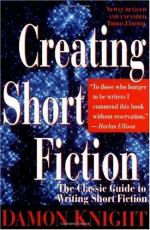
|
| Name: _________________________ | Period: ___________________ |
This test consists of 15 multiple choice questions and 5 short answer questions.
Multiple Choice Questions
1. What is the term used to describe the opposite of a satisfying resolution by Knight?
(a) Fade-in.
(b) Blank.
(c) Negative.
(d) Fade-out.
2. Which point of view does Knight believe proves to be most awkward?
(a) Third.
(b) First.
(c) Detached.
(d) Second.
3. Which of the following pronouns refers to the narrator when a story is written in the first person point of view?
(a) I.
(b) You.
(c) He.
(d) We.
4. What does Knight suggest is most important to consult when a writer hits a troublesome spot?
(a) His creative side.
(b) A professional editor.
(c) Another author.
(d) Dictionary or thesaurus.
5. If a reader already knows information that the writer is repeating, what does it become?
(a) Knowledge.
(b) Noise.
(c) Imagery.
(d) Detail.
6. Which of the following is a question Knight suggests the writer must ask about 'who'?
(a) Who is the story about?
(b) Who is telling the story?
(c) Who is the protagonist?
(d) Who is the reader?
7. What is the purpose of reviewing work after it is complete?
(a) Making sure that the idea shines through.
(b) Making sure the story is good.
(c) Finding a way to make the story shorter.
(d) Finding bits to change.
8. If the writer feels the story is becoming boring, what does Knight believe is necessary?
(a) Scrapping the story entirely.
(b) Making drastic cuts.
(c) Starting over with the same idea.
(d) Ending the story early.
9. If a writer has an idea but the phrasing is escaping him, what next course of action does Knight suggest should be next?
(a) Stop and take a break.
(b) Continue and come back to this part later.
(c) Consult a thesaurus or rhyming dictionary.
(d) Skip this part entirely.
10. Which of the following should a writer not do, according to Knight?
(a) Write westerns or commercial fiction.
(b) Pay attention to the market.
(c) Avoid having an editor.
(d) Revise a story many times.
11. What does Knight suggest is straightforward and no-nonsense?
(a) Style.
(b) Diction.
(c) Poetry.
(d) Prose.
12. According to Knight, what is the most important element that the ending offers a reader?
(a) Resolution.
(b) Conflict.
(c) Knowledge.
(d) Rising action.
13. Through which viewpoint can the writer enter only one character's mind?
(a) Limited omniscient.
(b) First person omniscient.
(c) Second person.
(d) Omniscient.
14. Knight gives an example that sometimes a new writer relies on what part of a character to create interest?
(a) Personality.
(b) Profession.
(c) Family.
(d) Romance.
15. Which of the following genres does Knight suggest is almost extinct?
(a) Historical.
(b) Western.
(c) Science fiction.
(d) Romance.
Short Answer Questions
1. What must a writer draw on to write the perfect ending?
2. Which of the following is not an example of a revision to a manuscript?
3. What genre was once the preeminent genre?
4. Which pronoun refers to the narrator in the third person point of view?
5. If the writer is creating a fictional town or building, how does Knight suggest creating integrity?
|
This section contains 505 words (approx. 2 pages at 300 words per page) |

|




